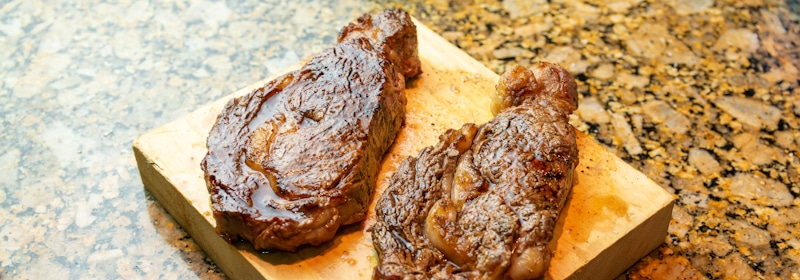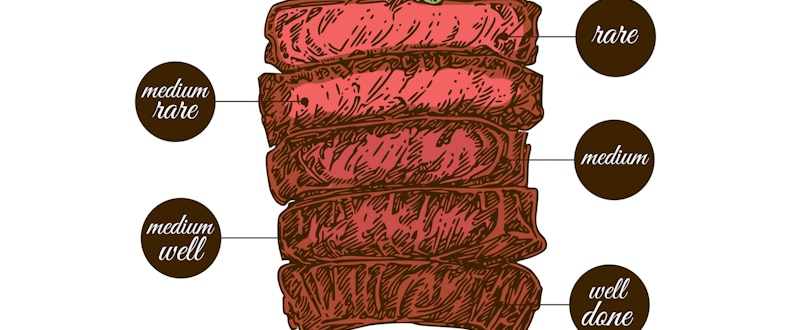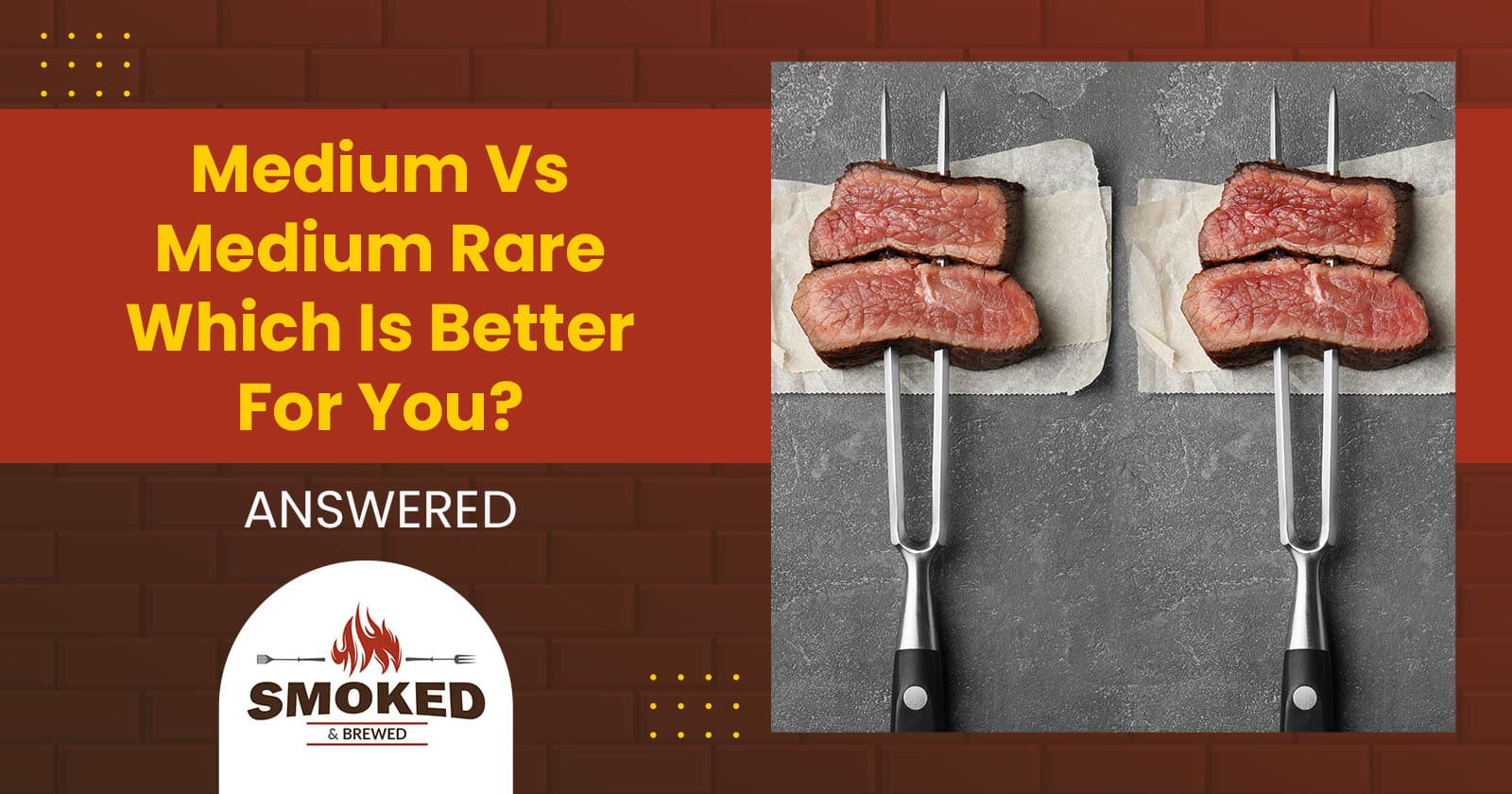Although both medium rare and medium are perfect levels of doneness, they differ in some ways. The internal meat temperature for medium steak is between 135 and 155 degrees Fahrenheit, while that of medium rare is between 130 and 135 degrees Fahrenheit. So, which level of doneness is better between medium and medium rare?
The answer to this question highly depends on personal preference and the cut of steak. Both levels of doneness offer an ideal way of preparing tasty, safe, and nutritious beef. Notably, although medium rare is more flavorful and juicier, most people like their meat fully cooked and hence find medium doneness more appealing.
If you are looking forward to grilling your meat to perfection, then understanding the pros and cons of the different levels of doneness will help you decide how best to cook your beef. This guide seeks to help you cook your meat to perfection and avoid an unsafe level of doneness.

What Is The Difference Between Medium Rare And Medium?
Medium rare and medium levels of doneness are pretty standard among barbecue enthusiasts. But what exactly do these two levels of doneness mean?
Medium rare meat is cooked for a shorter time than medium meat. Consequently, the flavor and the textures of the two levels of doneness differ. Medium rare tend to be pinkish, highly browned on the outside, and incredibly juicy. On the other hand, a medium level of doneness is tender, less pink, and less juicy.
What Is The Medium Level Of Doneness?
To understand the main differences between the two levels of doneness, you must scrutinize them separately.
Meat that has been cooked to a medium level of doneness tends to have a prominent pink band in the center, surrounded by brownish-gray fresh. The outside of such meat is usually well-cooked with caramelized meaty flavors. Further, the meat is, in most cases, soft with a slight chewiness.
How to Know the Meat is at Medium Level of Doneness
An instant meat thermometer is one of the essential tools you will always need if you want to cook your steak to perfection. A functional meat thermometer will make it possible for you to know when the meat attains the desired level of doneness.
For the medium level of doneness, you need to ensure that the meat has attained a 135-155 degrees Fahrenheit internal temperature. Using an instant thermometer is the most accurate way to tell when the meat attains the desired level of doneness.
However, it is also possible to tell when the meat has been cooked to medium doneness by timing. You can cook your meat to a medium level of doneness by cooking each side for three minutes. When using the time to determine the level of doneness, you should factor in the meat’s thickness and the fire’s strength.
What Is A Medium Rare Level Of Doneness?
A medium rare level of doneness steak has been cooked for a shorter time than the medium level of doneness. It will be okay to think of it as rawer and less cooked. Medium rare meat is pink on the inside with a slightly red appearance. The meat turns pink when it starts to cook.
How To Know The Meat Has Attained Medium Rare Level Of Doneness?
The most reliable way to determine the level of doneness of meat is to check the internal temperature of the meat using a digital meat thermometer.
Meat that has attained the medium rare level of doneness should have an internal temperature range of 130-135 degrees Fahrenheit.
If you are relying on the cooking time, you get to this level of doneness after cooking the meat for 2 minutes per side. You may need to adjust the time depending on the meat’s thickness and the grill’s temperature.
Medium Vs. Medium Rare – Which Is Best?
It depends on personal preference when deciding on the best level of doneness, medium vs. medium rare. If you do not like seeing anything that looks like blood on your meat, then thoroughly cooked and juicy-free meat will be the best option.
If you are unsure about the level of doneness that will serve you right, you may want to try both of them.
What Is The Difference In Terms Of Taste?
One of the reasons that make the level of doneness a debatable issue is a taste that one can get from each different of doneness.
While some people prefer a medium rare level of doneness for a perfect combination of juiciness, tenderness, and crispness on the edges, some will go for medium doneness because they do not like the red color standard is medium rare.
Regarding the difference, in terms of taste, a medium doneness level is delicious, less juicy, and has a pink color inside. On the other hand, medium rare is also delicious. However, it is juicier with red color on the inside. If you never find the bloody appearance on the inside of a steak appealing, then you are not likely to love this level of doneness.
Other Levels Of Doneness
When cooking your steak, you are not limited to medium rare vs. medium level of doneness. The truth is that there are several other levels of doneness. You have the privilege of deciding on the level of doneness that will serve you well.
Medium-Well Steak
A medium-well steak is mostly gray-brown with slight pinkish on the inside. It is still juicy and does not have blood oozing inside. As you may have already correctly figured out, to get to this level of doneness, you must cook the meat a little longer than medium. To perfectly attain this level of doneness, you may need to cook your steak for about five minutes on each side. Notably, medium-well steaks tend to have a rough texture but are slightly tender at the center.
Well-Done Steak
Another typical level of doneness is well-done steak. It is usually gray-brown and does not have any pink color inside. To get to this level of doneness, you may need to cook your steak for about 6 minutes on each side. One common characteristic of well-done steaks is that they are drier than other levels of doneness. Nonetheless, they are the most loved level of doneness.

Is It Healthy To Eat Rare, Medium, Or Medium-Rare Steak?
Suppose you talk to different people regarding their favorite level of doneness. In that case, you will discover that some people love rare, others medium rare, and some medium, and some will not accept anything less than a well-done steak. It all depends on personal preference.
The good news is that health-wise, you lose nothing by going for a rare or well-done level of doneness, as the level of protein, zinc, and iron remains the same regardless of the level of doneness. However, the concern is that meat cooked to a well-done level may contain more potential carcinogens known as heterocyclic amines than steaks cooked for a short time.
If you love a well-done steak and do not want to risk forming heterocyclic amines, then you may want to follow the following tips.
- Ensure that you grill small portions on the grill. The less time you spend grilling your meat, the less time for forming heterocyclic amines.
- Marinade the meat before grilling. Some ingredients, such as vinegar in the marinade, can help suppress the formation of heterocyclic amines.
- Add garlic and rosemary to your marinades, as herbs have been shown to block the formation of heterocyclic amines.
- Cook at lower temperatures
Final Words
Deciding whether to cook your meat to medium vs. medium rare should not give you a hard time. There is a difference in nutrients since all levels of doneness have the same amount of nutrients. The main factor that will influence your choice is taste and preference. However, you need to limit the time your steak stays on the grill to suppress the formation of heterocyclic amines.
Scot has loved smoking food in his free time for the last few years. Each major holiday or off-weekend, Scot spends days testing and prepping new recipes for perfection.

